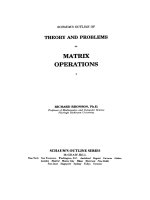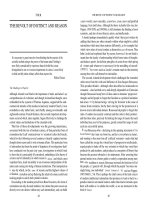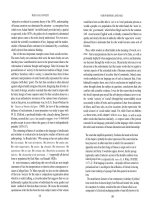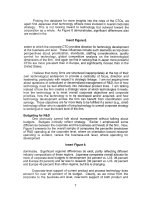schaum s easy outline of principles of economics based on schaum s outline of theory and problems of principl phần 7 potx
Bạn đang xem bản rút gọn của tài liệu. Xem và tải ngay bản đầy đủ của tài liệu tại đây (206.2 KB, 15 trang )
CHAPTER 9: Economic Growth and Productivity 85
True or False Questions
1. An economy’s standard of living is rising when real GDP is in-
creasing 10 percent while population is increasing 5 percent.
2. Assuming full employment of resources, an increase in the labor
force, ceteris paribus, always increases output per capita.
3. Additions to the economy’s stock of capital always result in cap-
ital deepening and capital widening.
4. Supply-side policies intend to increase the economy’s ability to
produce.
5. The slowdown in U.S. productivity growth was caused by capital
widening.
Answers: 1. True; 2. False; 3. False; 4. True; 5. False
Solved Problems
Solved Problem 9.1 Table 9.1 presents growth in real GDP for Country
A and Country B. For each country find:
a. Relative increase in output between 1984 and 1994.
b. Output per capita for 1984 and 1994.
Figure 9-1
86 PRINCIPLES OF ECONOMICS
c. Relative increase in output per capita between 1984 and 1994.
d. Which measure of economic growth, as calculated in a. or c., is
more useful?
Solution:
a. The relative increase in output is found by dividing 1994 GDP by
that for 1984. The relative increase in Country A’s real GDP is 2.0; thus,
Country A’s real GDP doubled between 1984 and 1994. The relative in-
crease for Country B is 2.45 for the same period.
b. An economy’s per capita GDP is found by dividing real GDP by
the economy’s population. In Country A, per capita output is $3,915.66
in 1984 and $5,803.57 in 1994. Country B’s per capita output increased
from $3,915.66 in 1984 to $4,796.67 in 1994.
c. The relative increase in per capita output between 1984 and 1994
is found by dividing per capita output in 1994 by that in 1984. The rela-
tive increase in per capita output is 1.48 for Country A and 1.22 for Coun-
try B.
d. Economic growth is frequently presented as the increase in real
GDP. While useful for some analysis, increases in real GDP do not mea-
sure the economic well-being of individuals in an economy, which is best
measured by increases in per capita output. The calculations in parts a.
and c. show how one might reach different conclusions about an econo-
my’s economic growth. Country B’s real GDP more than doubled be-
tween 1984 and 1994, while A’s only doubled; B obviously has increased
its output at a faster rate than A. On a per capita basis, however, output
per capita increased more rapidly in Country A than B. Which measure is
more useful depends upon one’s intent in measuring growth. When one
is only interested in the increase in aggregate output, growth in real GDP
Table 9.1
is the relevant measure. However, when the focus is upon the standard of
living in the economy, output per capita is the better measure of economic
growth.
Solved Problem 9.2 What objections, if any, are there to economic
growth?
Solution: Some economists object to maximizing economic growth be-
cause in doing so it may possibly affect the quality of life, in such ways
as pollution of the environment or waste of natural resources. Maximized
economic growth may also fail to resolve socioeconomic problems or
may exacerbate them. Rapid economic growth through technological
change in many instances increases worker obsolescence (workers no
longer have skills needed in the labor market), brings about new anxieties
and insecurities, and undermines family relationships as the workplace
takes on greater importance than human relationships. Although attempts
are being made to curb pollution, industrial waste is a by-product of in-
creased output. It therefore can be expected that water, land, and air pol-
lution will increase with time. Waste of economic resources may also re-
sult when least-cost methods dictate current resource use with little
attention paid to the possible effect that current use may have upon fu-
ture generations. And there is no guarantee that growth resolves socio-
economic problems such as poverty. Poverty in an economy is relative to
the economy’s standard of living. Thus, growth does not resolve the prob-
lem of relative poverty, which is only resolved by a redistribution of cur-
rent income.
CHAPTER 9: Economic Growth and Productivity
87
Chapter 10
International
Trade and
Finance
In This Chapter:
✔ Basis of and Gains from Trade
✔ Obstacles to Trade
✔ Balance of Payments
✔ Exchange Rates
✔ True or False Questions
✔ Solved Problems
Basis of and Gains from Trade
Thus far, we have assumed a relatively closed econ-
omy, or an economy isolated from the rest of the
world. In reality, most nations are open economies.
That is, they are connected to other nations through
a network of trade and financial relationships. These
relationships have great advantages but they may
also result in problems. Even though trade is gener-
ally more important to small than to large developed
nations, the welfare of the latter is also greatly dependent on trade.
Since the availability of resources differs among nations, the oppor-
88
Copyright 2003 by The McGraw-Hill Companies, Inc. Click Here for Terms of Use.
tunity cost of producing more of a commodity (in terms of the amount of
another commodity that would not be produced) also usually differs
among nations. In a two-nation, two-commodity world, each nation
should specialize in the production of the commodity with the lower op-
portunity cost; this is the commodity in which the nation has a compara-
tive advantage. The nation should trade part of its output with the other
nation for the commodity with the higher opportunity cost (the one in
which the nation has a comparative disadvantage). This leads to a larger
combined output of both commodities than would occur in the absence
of specialization and trade.
Note!
Comparative advantage is the key to trade among
countries.
Example 10.1
Figure 10-1 shows a hypothetical production-possibilities frontier for
cloth (C) and food (F) for the U.S. and U.K. under constant costs (the
solid lines).
CHAPTER 10: International Trade and Finance
89
Figure 10-1
It shows that the U.S. could produce alternatives including 40C and
0F, or 0C and 80F. For each unit of cloth the U.S. gives up, it releases re-
sources to produce two additional units of food. The domestic cost ratio
is 1C = 2F, or 1/2C = 1F, and is constant in the U.S. In the U.K., 2C =
1F. Since the opportunity cost of F is 1/2C in the U.S. and 2C in the U.K.,
the U.S. has a comparative advantage in F. Similarly, the U.K. has a com-
parative advantage in C. Suppose that in the absence of trade, the U.S.
and U.K. produced and consumed at points A (20C and 40F ) and AЈ (20C
and 20F), respectively. With trade, the U.S. should specialize in the pro-
duction of F and produce at B (80F and 0C) and the U.K. should spe-
cialize in C and produce at BЈ (60C and 0F). By then exchanging, say,
30F for 30C with the U.K., the U.S. would end up consuming at E (30C
and 50F) and the U.K. would consume at EЈ (30C and 30F ). Thus, both
the U.S. and the U.K. end up consuming 10C and 10F more than without
specialization and trade (compare E with A and EЈ with AЈ). With in-
creasing opportunity costs, the production-possibilities frontiers are con-
cave or bulge outward, and there would be incomplete specialization in
production.
Obstacles to Trade
Even though trade can be the source of major gains, most nations restrict
the free flow of trade by imposing tariffs, quotas, and other obstructions.
An import tariff is a tax on the imported commodity. An import quota is
a quantitative restriction on the amount of a good
that may be imported during a year. Other restric-
tions include health regulations and safety and pol-
lution standards. Trade restrictions are advocated
by labor and firms in some industries as a protec-
tion against foreign competition. These restric-
tions, however, generally impose a burden on society as a whole because
they reduce the availability of goods and increase their prices. Some of
the specific arguments advanced for trade restrictions are: (1) to protect
domestic labor against cheap foreign labor; (2) to reduce domestic un-
employment; (3) to protect young or “infant” industries; and (4) to pro-
tect industries important for national defense. Most of the arguments are
invalid and are based on misconceptions.
90 PRINCIPLES OF ECONOMICS
You Need to Know
Trade restrictions are often supported by groups
that will specifically benefit from the restrictions, of-
tentimes at the expense of other groups.
Balance of Payments
The balance of payments is a yearly summary statement of a nation’s
transactions with the rest of the world. The balance of payments is di-
vided into three major sections: (1) current account, which shows flows
of good and services and government grants; (2) capital account, which
shows flows of investments and loans; and (3) official reserve account,
which shows the change in the nation’s official government reserves and
liabilities to balance the current and capital accounts.
The nation gains foreign currencies by exporting goods and services
and receiving capital inflows (i.e., investments and loans) from abroad;
all of these are credits. The nation spends these foreign currencies to im-
port goods and services and to invest and lend abroad; these are debits.
When the sum of all these debits exceeds the sum of the credits in the cur-
rent and capital accounts, the nation has a deficit in its balance of pay-
ments equal to the difference. The deficit is settled by a reduction in the
nation’s reserves of foreign currency or by an increase in the foreign
country’s holdings of the deficit nation’s currency. The opposite is true
for a balance-of-payments surplus.
Exchange Rates
A nation generates a supply of foreign currencies or monies in the process
of exporting goods and services and receiving grants, investments, and
loans from abroad. On the other hand, the nation uses foreign currencies
to import goods and services and to make grants, investments, and loans
abroad. When foreign currencies can be freely bought and sold, the rate
of exchange between the domestic and a foreign currency is determined
by the market demand for and the supply of the foreign currency. If the
CHAPTER 10: International Trade and Finance 91
demand for the foreign currency increases, the rate of exchange rises.
That is, more domestic currency is required to purchase one unit of the
foreign currency (so that the domestic currency depreciates).
Example 10.2
In Figure 10-2, D is the U.S. demand and S is the U.S. supply curve for
pounds (£, the currency of the U.K.).
92 PRINCIPLES OF ECONOMICS
Figure 10-2
D is downward sloping because at lower dollar prices for pounds it is
cheaper for the U.S. to import from, invest in, and extend loans to the
U.K. S is upward sloping because at higher dollar prices for pounds, it is
cheaper for the U.K. to import from, invest in, and extend loans to the
U.S. D and S intersect at the equilibrium rate of exchange of $2 = £1 and
the equilibrium quantity of £300 million. If D shifts up to DЈ, the rate of
exchange rises to $3 = £1. If, on the other hand, the rate of exchange is
not allowed to rise (as under the fixed-exchange system), the U.S. would
have a deficit with the U.K. of EF = £200 = $400 million in its balance
of payments. This deficit could only be corrected by reducing the level of
national income, by allowing domestic prices to rise less than abroad, or
by government control of trade and payments.
Note!
Foreign currencies have prices (i.e., exchange
rates), just like any other good or service.
From the end of World War II until 1971, the world operated under
a fixed-exchange-rate system known as the Bretton Woods System. Un-
der this system, the U.S. faced large and chronic deficits, which it was
justifiably unwilling to correct by domestic deflation or direct controls on
trade and payments. The resulting lack of adjustment forced the aban-
donment of the fixed-exchange-rate system and the establishment of a
flexible-exchange-rate system. However, the system that is in operation
today is not freely flexible or completely floating because national mon-
etary authorities intervene in foreign exchange markets to prevent errat-
ic and unwanted fluctuations in exchange rates.
True or False Questions
1. Large countries are generally more open than small countries.
2. When each nation specializes in the production of the commodi-
ty of its comparative advantage, the combined output of both commodi-
ties increases.
3. Import restrictions are required to protect the nation’s labor
against foreign competition.
4. A nation has a surplus in its balance of payments if its total cred-
its exceed its total debits in its current and capital accounts.
5. A deficit in a nation’s balance of payments is corrected by a de-
preciation of its currency under a fixed-exchange-rate system.
Answers: 1. True; 2. True; 3. False; 4. True; 5. False
Solved Problems
Solved Problem 10.1
a. How can we measure a nation’s degree of economic interdepen-
dence with the rest of the world?
b. Why does the U.S. rely less on trade than most other developed
nations?
c. What would happen to its standard of living if the U.S. withdrew
completely from international trade?
Solution:
a. A rough measure of the degree of interdependence of a nation with
the rest of the world is given by the value of its exports as a percentage
of its GDP.
CHAPTER 10: International Trade and Finance 93
b. The U.S. is a nation of continental size with immense natural and
human resources. As such, it can produce with relative efficiency most of
the products it needs. In contrast, a small nation can only specialize in the
production and export of a small range of commodities and must import
all the others. In general, the larger the nation, the smaller its economic
interdependence with the rest of the world.
c. Even though the U.S. relies only to a relatively small extent on for-
eign trade, a significant part of its high standard of living depends on it.
For one thing, the U.S. is incapable of producing such commodities as
coffee, tea, and Scotch whiskey. In addition, the U.S. has no known de-
posits of such minerals as tin and tungsten, which are important for in-
dustrial production. It also needs to import huge quantities of petroleum.
In addition, there are many commodities that the U.S. could produce do-
mestically but only at a relatively higher cost than the costs of some for-
eign countries. Thus, trade is very important to the welfare of the U.S.
Solved Problem 10.2
a. Cite some of the specific arguments advanced in favor of trade pro-
tection.
b. Evaluate these arguments.
Solution:
a. Protection is often advocated to protect domestic labor against
cheap foreign labor. That is, since wages are generally higher in the U.S.
than in other nations, without protection foreign nations can undersell the
U.S. because of the lower wages. Another argument for protection is that
it reduces domestic unemployment. By restricting imports, domestic pro-
duction is stimulated and unemployment is reduced. A third argument in
favor of protection is the “infant industry” argument. This states that a
newly established industry requires protection until it can grow in size
and efficiency so as to be able to face foreign competition. Finally, pro-
tection is advocated in order to protect such industries as shipyards that
are important for national defense.
b. The argument for protection against cheap foreign labor is gener-
ally invalid because it incorrectly implies that higher wages necessarily
mean higher labor costs. This is not true if the higher U.S. wages are based
on even higher labor productivity. Restrictions on U.S. imports to reduce
U.S. unemployment is a beggar-thy-neighbor policy because it leads to
higher unemployment in those nations whose exports to the U.S. have
94 PRINCIPLES OF ECONOMICS
been restricted. As a result, these other nations can retaliate and also re-
duce imports from the U.S., and all nations lose in the end. The infant-in-
dustry argument is generally invalid for the U.S. and other industrial na-
tions but may be valid for poor developing nations. However, the same
degree of protection can generally be better achieved by subsidies to the
infant industry rather than by tariffs and quotas. Subsidies are also gen-
erally preferable to tariffs and quotas as protection to industries impor-
tant for national defense.
Solved Problem 10.3
a. What happens to the equilibrium rate of exchange and to the equi-
librium quantity of foreign exchange if the nation’s demand for the for-
eign currency decreases? Why?
b. How is a deficit or a surplus in a nation’s balance of payments cor-
rected under a flexible-exchange-rate system?
Solution:
a. Given the nation’s supply curve of the foreign currency, a down-
ward shift in the nation’s demand curve for the foreign currency will de-
termine a new and lower equilibrium exchange rate and equilibrium
quantity. A decrease in the nation’s demand for a foreign currency may
result from a change in tastes for less imported goods and services. It may
also occur if the nation decreases its investments and loans abroad in the
expectation of decreased returns.
b. A deficit in a nation’s balance of payments means that at a given
rate of exchange, there is a shortage (an excess of quantity demanded over
quantity supplied) of the foreign currency. If the exchange rate is freely
flexible or floating, the exchange rate will rise until the quantity de-
manded of the foreign currency equals the quantity supplied and the
deficit is completely eliminated. This rise in the exchange rate means that
the relative value of the domestic currency is falling or depreciating. The
exact opposite occurs when there is a surplus and the nation’s currency
appreciates (or increases) in relative value.
CHAPTER 10: International Trade and Finance
95
Chapter 11
Theory of
Consumer
Demand and
Utility
In This Chapter:
✔ Law of Diminishing Marginal Utility
✔ Utility Maximization
✔ Derivation of Individual Demand
Curve
✔ True or False Questions
✔ Solved Problems
Law of Diminishing Marginal Utility
In previous chapters, we saw that the market demand curve for a com-
modity is derived by adding the individual’s demand curves for the com-
modity. We also saw that each individual’s (and thus the
market) demand curve for a commodity is downward-
sloping because of the substitution and income effects.
However, an individual demands a particular com-
modity because of the satisfaction, or utility, he or she re-
96
Copyright 2003 by The McGraw-Hill Companies, Inc. Click Here for Terms of Use.
ceives from consuming it. The more units of a commodity the individual
consumes per unit of time, the greater is the total utility he receives. Al-
though total utility increases, the extra, or marginal, utility received from
consuming each additional unit of the commodity decreases. This is re-
ferred to as the law of diminishing marginal utility.
Example 11.1
For purposes of illustration, we assume in Table 11.1 that satisfaction can
actually be measured in terms of units of utility called utils. The first two
columns of Table 11.1 give an individual’s hypothetical total utility (TU)
schedule from consuming various quantities of commodity X (say or-
anges) per unit of time.
Note that as the individual consumes more units of X, TU
x
increases.
Columns 1 and 3 of the table give this individual’s marginal utility (MU)
schedule for commodity X. Each value of column 3 is obtained by sub-
tracting two successive values of column 2. For example, if the individ-
ual’s consumption of X rises from 1 unit to 2 units, TU
x
rises from 10 to
18, and the MU of the second unit of X is 8.
Remember
Utility models can be used to predict
how consumers will act even if the
consumers do not specifically think
in terms of units of utility.
CHAPTER 11: Theory of Consumer Demand and Utility 97
Table 11.1
Utility Maximization
A consumer maximizes the total utility or satisfaction obtained from
spending his income and is in equilibrium when the marginal utility of
the last dollar spent on each commodity is the same. This equilibrium
condition for utility maximization can be restated as follows:
Example 11.2
Table 11.2 shows the marginal utility that an individual receives from
consuming various units of X and Y per unit of time. Suppose that the con-
sumer has $7 to spend on X and Y, and that P
x
(the price of X) = $2 and
P
y
= $1. This consumer maximizes total utility and is in equilibrium by
spending $4 of his $7 to buy 2X and the remaining $3 to purchase 3Y. At
this point, MU
x
/ P
x
= 8 utils / $2 = MU
y
/ P
y
= 4 utils / $1 = MU of 4 utils
from the last $ spent on X and Y. By purchasing 2X and 3Y, TU
x
= 18
(from 10 + 8), TU
y
= 15 (from 6 + 5 + 4), and TU from both is 33 utils.
MU MU
common MU of last $ spent on each commodity
x
x
y
yPP
===
98 PRINCIPLES OF ECONOMICS
Table 11.2
Derivation of Individual Demand Curve
Starting with an equilibrium, we get one point on a consumer’s demand
curve. At a lower commodity price, the consumer must purchase more of
the commodity to be in equilibrium, and so we can get another point on
that demand curve. From these and other points of consumer equilibri-
Note!
Utility maximization theory gives a formula to help
explain the shape of the individual demand curve.
um, we can derive a downward sloping demand curve because of dimin-
ishing MU. Because MU declines, the price must fall to induce the indi-
vidual consumer to buy more of the commodity.
Consumer’s surplus refers to the difference between what the con-
sumer would be willing to pay to purchase a given number of units of a
commodity and what he actually pays for them. It arises because the con-
sumer pays for all units of the commodity the price he is just willing to
pay for the last unit purchased, even though the MU on earlier units is
greater. Consumer surplus can be measured by the area under the con-
sumer’s demand curve and above the commodity price.
You Need to Know
Consumer surplus arises from the different prices
consumers would be willing to pay for different
quantities of the same good. Imagine how much
you would be willing to pay for your first phone call
each month, as opposed to your fiftieth call.
Example 11.3
In Figure 11-1, the consumer purchases AF units of the commodity at
price AB and spends AB times AF (the area of the rectangle ABCF) on
this commodity. However, this consumer would have been willing to pay
a higher price for all but the last unit of this commodity purchased (as in-
dicated by the height of her demand curve) because these previous units
give her a greater MU than the last unit purchased. The difference be-
CHAPTER 11: Theory of Consumer Demand and Utility 99









